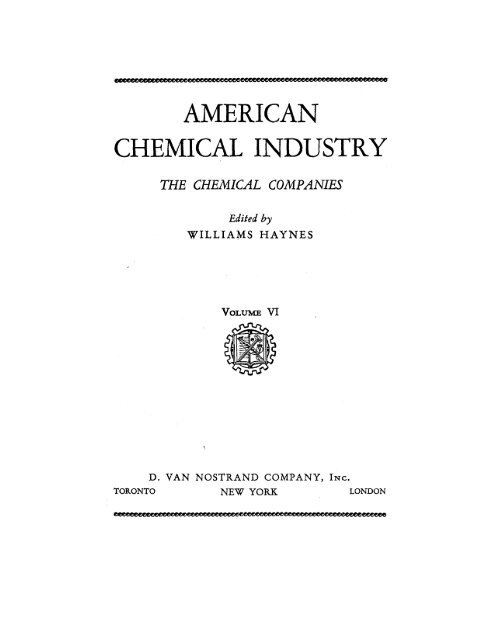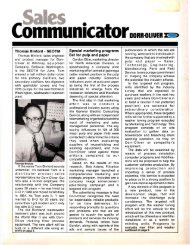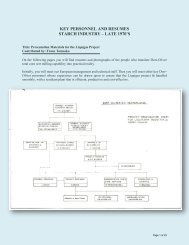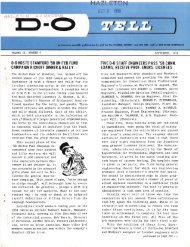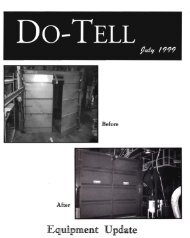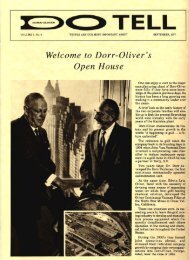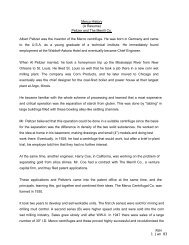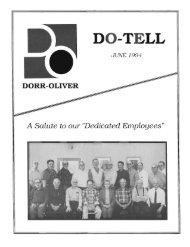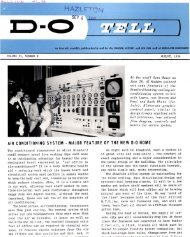THE DORR COMPANY / pgs. - Dorr-Oliver Alumni
THE DORR COMPANY / pgs. - Dorr-Oliver Alumni
THE DORR COMPANY / pgs. - Dorr-Oliver Alumni
You also want an ePaper? Increase the reach of your titles
YUMPU automatically turns print PDFs into web optimized ePapers that Google loves.
<strong>THE</strong> <strong>DORR</strong> <strong>COMPANY</strong> / <strong>pgs</strong>. 109 - 113<br />
<strong>DORR</strong> <strong>COMPANY</strong>, with its world-wide activities, is very much the lengthening shadow of<br />
its founder and president, John Van Nostrand <strong>Dorr</strong>, and of his inventive genius. Born in<br />
Newark, N. J., 1872, <strong>Dorr</strong> was educated in private schools and graduated from Rutgers in<br />
1894, with a B.S. in chemistry. Prior to college, he worked two years directly under<br />
Thomas A. Edison as a chemical experimenter.<br />
After a short period of industrial chemical work in the East after graduation, <strong>Dorr</strong> went<br />
West to become chemist at a smelter at Deadwood, S. D., in the Black Hills. This was a<br />
period of great developments in metallurgy, when the refractory gold ores of "The Hills"<br />
were being treated by smelting, chlorination, and the newly developed cyanide process.<br />
<strong>Dorr</strong> left the smelter to learn more about the latter process, and, after a short time in<br />
Colorado, returned to Deadwood, where in 1902 he formed a partnership with John<br />
Lundberg, a mine leaser, to operate a cyanide mill, the Rossiter Mill, to treat gold ores<br />
from Lundberg's two leaseholds, the Buxton and the Bonanza Mines. In 1903 the partners<br />
purchased the two mines, erected a 100-ton per day wet crushing cyanide mill on the site,<br />
and took in a third partner, A. D. Wilson, a civil engineer. At the Lundberg, <strong>Dorr</strong> & Wilson<br />
mill, <strong>Dorr</strong> tried out the new Moore filter process, a large cone for the continuous collection<br />
of slimes, and a Chile mill in place of the stamps used in the district. To effect a clean-cut<br />
separation between fine slimes and coarse sands prior to separate cyanide treatment, the<br />
<strong>Dorr</strong> clarifier was developed, patented, and arrangements made for its manufacture.<br />
In 1906 <strong>Dorr</strong> was engaged as consultant on the remodeling of the dry crushing mill of the<br />
Mogul Mining Co., which was having trouble with slime collection. He conceived the idea<br />
of continuous slime thickening in flat-bottomed tanks and developed the first <strong>Dorr</strong><br />
continuous thickener. In 1910 came the <strong>Dorr</strong> agitator and later two new principles:<br />
continuous countercurrent decantation and closed circuit grinding. The engineering<br />
principle underlying these inventions was that mechanical means were necessary for<br />
most efficient continuous handling and treatment of finely divided solids suspended in<br />
liquids. Manufacturing arrangements were made in Denver and Chicago and <strong>Dorr</strong> began<br />
to build an engineering organization to market his inventions and the engineering services<br />
that went with them, while continuing to manage two mining properties in the Black Hills.<br />
In 1910 the <strong>Dorr</strong> Cyanide Machinery Co was formed to become in 1916 the <strong>Dorr</strong> Co.,<br />
Engineers.<br />
Interests had been given to various associates at the beginning. Among these was<br />
William Russell of Glasgow, who came to the United States for the McArthur-Forrest Co.,<br />
patentees of the cyanide process. He joined <strong>Dorr</strong> in 1911 and made a trip that year to<br />
South Africa for the Company, later becoming head of its London associate, <strong>Dorr</strong>-<strong>Oliver</strong><br />
Co., Ltd., from which he retired as chairman in 1946. Luther Eames, who assisted in the<br />
development of the thickener in 1906, is still a stockholder and associated with one of the<br />
company’s manufacturing <strong>Dorr</strong> equipment. The late H. Norman Spicer made the first trip<br />
around the world for the Company in 1911-12. Edwin C. Reybold, an early Black Hills<br />
associate, is still with <strong>Dorr</strong> Co.; Elmer R. Ramsey, who joined in 1914, is operating vicepresident<br />
and a director. Zay Jeffries, who worked with the classifier in 1904 while still an
undergraduate, has become a distinguished scientist in other fields and a vice-president<br />
of the General Electric Co. Another early associate of the classifier development era,<br />
Edward Johnson, nephew of John Lundberg, was on the staff at the Westport, Conn.,<br />
Laboratories until his death in 1947.<br />
The technological developments in ore dressing and wet metallurgy during the 1920's<br />
greatly increased the demands for <strong>Dorr</strong> machinery and engineering services in this<br />
country and abroad. A territorial growth began. The first commercial office was opened in<br />
Denver in 1907. In 1913 Spicer left Denver to open a one-room office in New York, which<br />
later became headquarters. Branch offices followed: Chicago, 1922; Los Angeles, 1923;<br />
Toronto and Atlanta, 1926. The first European office was opened in London, in 1912, in<br />
charge of Russell. The same year Edward L. Bateman, Johannesburg, became Company<br />
representative in South Africa and Rhodesia. Later came offices in Paris and Berlin, 1925;<br />
Brussels, 1930; The Hague (now Amsterdam), 1931; and Milan, 1937. Except for Berlin,<br />
these cities are headquarters of the five <strong>Dorr</strong>-<strong>Oliver</strong> Companies, wholly owned<br />
subsidiaries organized under the laws of their respective nations, which both manufacture<br />
and market products of the parent company and of <strong>Oliver</strong>-United Filters, Inc., San<br />
Francisco.<br />
The Company has had representatives in Mexico City since 1908 ; Melbourne, Australia,<br />
1911; Rio de Janiero, 1920 ; Buenos Aires, 1924 ; Tokyo, 1929 ; Caracas, Venezuela,<br />
1946. In addition, its Petree & <strong>Dorr</strong> Division, operating exclusively in the cane sugar field,<br />
established representation in Havana, 1920; Hawaii, Puerto Rico, and the Philippines,<br />
1923 ; India, 1933 ; Mexico, 1941; Colombia, Mozambique, and Angolia, 1942.<br />
Originally the Company's business was related directly to the cyanidation of gold and<br />
silver ores in this country and in Mexico. The iron, lead, copper, phosphate, and sand<br />
fields were also entered in a small way. Ultimately not only all of wet metallurgy, but also<br />
most of heavy chemical and industrial processing, sugar manufacture, and sewage,<br />
water, and trade-waste treatment became <strong>Dorr</strong> customers.<br />
An early application in the chemical field was in the continuous manufacture of caustic<br />
soda by the lime-soda process. Closely related to cyanide treatment, the causticizing<br />
reaction took place in a series of agitators, sedimentation and washing in a series of<br />
thickeners, while a classifier at the head of the system removed inert materials from the<br />
milk of lime. The same principles were subsequently applied to the manufacture of<br />
phosphoric acid by wet methods, aluminum sulfate, alumina and magnesium, barium<br />
sulfide, lithopone, and titanium pigment, and many other chemical products.<br />
The preparation of finely divided water-floated clays, pigments, and abrasives by<br />
continuous methods opened up another broad field for the classifier and thickener. The<br />
wet process cement industry changed from open to closed circuit grinding. Practically all<br />
sulfate pulp mills standardized on the <strong>Dorr</strong> continuous recausticizing system. In the beet<br />
sugar industry the <strong>Dorr</strong> continuous first carbonation process and the lime mud thickener<br />
were installed in over three-quarters of the North American producing capacity, while the
<strong>Dorr</strong> de-ionization system is increasing sugar yields. The cane sugar field is a broad user<br />
of the <strong>Dorr</strong> cane juice clarifier and <strong>Oliver</strong>-Campbell filter.<br />
The loan in 1914 of a small experimental thickener td Chicago's Sanitary District led to a<br />
vast new field which in normal times amounts to about one-third of the Company's<br />
business. The initial objective was the continuous clarification of domestic sewage. The<br />
clarifier, an adaptation of the thickener principle, proved to be the solution. Intensive<br />
studies of this new field resulted in the development of a complete line of special<br />
equipment, which has been found to be directly applicable to the treatment of municipal<br />
sewage and water supplies, and to liquid industrial wastes and sources of process water.<br />
The three original machines, produced with only a nominal development cost, have been<br />
expanded to over 30, of which there are over 75 different types. However all are<br />
inherently based on the same fundamental principles involving classification,<br />
sedimentation, and agitation.<br />
The Westport, Conn., Mill acquired in 1917 and equipped to carry out all the Company's<br />
research and testing, supplanted two earlier, small test plants in Denver and New York. A<br />
modern research plant was built in 1937 on the foundation of the old one destroyed by fire,<br />
and in 1944 a pilot plant was added. Care was taken to preserve outwardly the lines of the<br />
original mill building, dating back to the Revolution, the beauty of the site, and the<br />
atmosphere and environment in which it had been found that the research man thrives and<br />
produces at his best.<br />
At Westport, aptly called the "<strong>Dorr</strong> workshop," a complete integrated technical service<br />
operates in collaboration with the Company's Consulting Engineering Department for<br />
carrying a new project through research, pilot-plant, and design. Many clients with wellequipped<br />
and well-staffed research facilities bring their solid-liquid phase problems to<br />
Westport for solution. Likewise the Company has frequently taken its problems to<br />
university and independent research laboratories. A research fellowship at Rutgers<br />
University established many fundamentals underlying the art of sewage sludge digestion.<br />
Another at the Mellon Institute yielded the basic facts governing the flocculation of<br />
ultrafine solids in sewage, water, and chemical solutions. A third at the University of<br />
Minnesota led to major improvements in methods of grinding and blending the raw<br />
materials of wet-process cement manufacture.<br />
Work of this type, plus the fact that, basically, the Company's business is the solving of<br />
technical problems, has led it into the development of new processes just as much as<br />
into purely equipment development. Whereas only 37% of its last 500 United States<br />
patents relate to processes, the ratio has increased to 67% among the last 100 of these.<br />
It has never been the Company's policy to own its production facilities as its products are<br />
so varied that they can best be made in jobbing shops. Furthermore, patents and other<br />
considerations require great flexibility. Manufacturing has also been carried on in this<br />
same manner by its European associated companies, and in some instances, by its<br />
other representatives outside the country.
On the Company's staff are many with long years of service. Two from the Black Hills<br />
days are still active in the Company, and two others have only recently retired. In 1946,<br />
of the domestic staff of 350, 47% had been with the organization 5-10 years; 10% for 10-<br />
15 years; and 6% for more than 25 years. Furthermore, the six members of the executive<br />
committee, all officers, averaged 27 years of continuous service and 11 on the operating<br />
committee averaged 23 years.<br />
<strong>Dorr</strong> is president and chairman of the Company and of <strong>Dorr</strong>-<strong>Oliver</strong> Co. His brother,<br />
Goldthwaite H. <strong>Dorr</strong>, assistant to Assistant Secretary of War Crowell, and Secretary of<br />
War Stimson during both wars, is vice-president and general counsel. Elmer R. Ramsey<br />
is operating vice-president ; Frank A. Downes, vice-president, research and development<br />
; H. E. Haws, treasurer; J. Delano Hitch, vice-president, sales ; Douglas C. Reybold,<br />
secretary-controller ; and Arthur Terry, Jr., vice-chairman of the board, <strong>Dorr</strong>-<strong>Oliver</strong> Co.<br />
Two things have characterized the Company from the very beginning: worldwide<br />
interests and the recognition that its function is to solve problems or render engineering<br />
services, whether in the form of specialized equipment, plant design, or research, or all<br />
three. Its equipment was originally developed by its founder while managing properties to<br />
meet needs, and its early work featured plant design with one case of erection and<br />
management operation. The almost unexpected growth of the whole business led to the<br />
development and marketing of equipment becoming its principal function. Its original<br />
engineering approach, with the commercial influence in the background, has probably<br />
made it less of ,a financial, but more of an engineering success thy it might otherwise<br />
have been.<br />
Currently, the Company's 12 most active fields are: cane and beet sugar, pulp and<br />
paper, municipal sewage and water, cement, gold and silver, sand and gravel,<br />
phosphate rock, industrial water, iron ore and copper. They yielded over three-quarters of<br />
the dollar volume of orders entered in 1947—a year in which over one-third of the<br />
business came from abroad.<br />
John V. N. <strong>Dorr</strong> has been many times honored by the metallurgical profession for his<br />
contributions to the arts of ore dressing and hydrometallurgy, and by the chemical<br />
engineering profession for his contributions to their problems of low-cost mass production.<br />
In accepting these honors, he has bestowed a large measure of the credit upon his own<br />
professional associates and the Company that has brought practical realization to the<br />
ideas which he originated.


